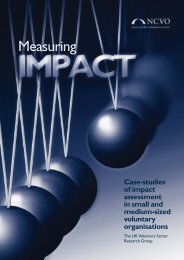A guide to third sector trading - WCVA
A guide to third sector trading - WCVA
A guide to third sector trading - WCVA
You also want an ePaper? Increase the reach of your titles
YUMPU automatically turns print PDFs into web optimized ePapers that Google loves.
It’s an idea, but is it business? A <strong>guide</strong> <strong>to</strong> <strong>third</strong> sec<strong>to</strong>r <strong>trading</strong><br />
1: Getting<br />
started<br />
2: First steps 3: Business<br />
planning<br />
4: Legal and<br />
governance<br />
5: Funding<br />
and<br />
resourcing<br />
6: Financial<br />
controls<br />
7: Managing<br />
growth<br />
8: Management<br />
and<br />
governance<br />
9: Social<br />
enterprise<br />
10: Sources<br />
of support<br />
• the direc<strong>to</strong>rs’ terms of service, including any remuneration<br />
− the continuation or dissolution of the <strong>trading</strong> subsidiary.<br />
Direc<strong>to</strong>rships and employment:<br />
• Employment of charity trustees:<br />
− Charity trustees may not be employed by their subsidiaries<br />
unless this is permitted by their Memorandum and Articles<br />
of Association or the Charity Commission has given specific<br />
approval.<br />
− A subsidiary company cannot be used as means <strong>to</strong> circumvent<br />
the bar on trustees receiving payments from the charity.<br />
• Membership of the subsidiary’s board:<br />
− It is good practice for some of the trustees and/or employees<br />
of the charity <strong>to</strong> become direc<strong>to</strong>rs of the <strong>trading</strong> subsidiary<br />
and <strong>to</strong> moni<strong>to</strong>r its performance. This is <strong>to</strong> ensure that the<br />
subsidiary is managed in the interests of the parent charity.<br />
− Anyone involved with the administration of both boards has<br />
two distinct responsibilities, and it can at times be difficult<br />
<strong>to</strong> balance conflicting pressures. It can be important that<br />
this potential tension is clearly unders<strong>to</strong>od by all the board<br />
members not just the individual.<br />
Independent or ‘unconflicted’ direc<strong>to</strong>rs:<br />
• As a matter of good governance, the Charity Commission<br />
recommends that there should be both:<br />
− at least one person who is a trustee, but not a direc<strong>to</strong>r or<br />
employee of the <strong>trading</strong> subsidiary (called an ‘unconflicted<br />
trustee’) and<br />
− at least one person who is a direc<strong>to</strong>r of the <strong>trading</strong> subsidiary,<br />
but not a trustee or employee of the charity.<br />
• Unconflicted trustees and direc<strong>to</strong>rs should advise their<br />
colleagues when their dual responsibilities result in conflicts<br />
of interest. This is important <strong>to</strong> reduce the risk of challenges <strong>to</strong><br />
transactions between the charity and its subsidiary.<br />
Handling financial problems in the<br />
<strong>trading</strong> subsidiary<br />
Protecting the charity’s interest: The interests of the parent<br />
charity must always come first. This will sometimes mean<br />
liquidating or selling a failing <strong>trading</strong> subsidiary.<br />
The Trustees’ obligation is <strong>to</strong> minimise any losses <strong>to</strong> the charity,<br />
irrespective of their loyalty or sense of moral obligation <strong>to</strong> the<br />
direc<strong>to</strong>rs and employees of the <strong>trading</strong> subsidiary.<br />
230












